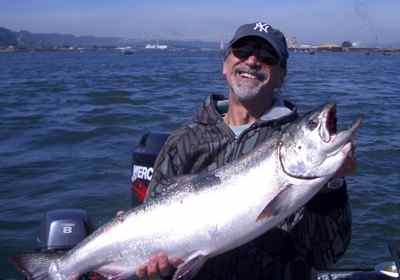 This might start off sounding like a fairy story but the giants mentioned here are real and they are out there waiting for you.
This might start off sounding like a fairy story but the giants mentioned here are real and they are out there waiting for you.
The last two nights I have been awakened by horrible cramps in my legs. I’m sure you all know what that’s like. There are a lot of theories as to why this happens to us. Not enough salt, dehydration etc etc. But on this occasion I can be fairly sure it was due to a concentration of lactic acids built up whilst fighting monster fish and having no warm-down exercise period to disperse those acids. What is it they say? No gain without pain. Weird, yet I was happy to be in agony.
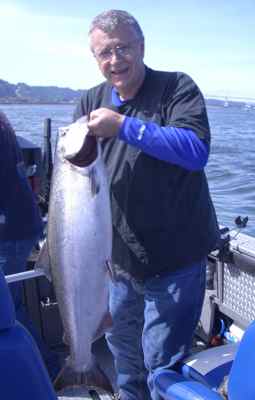
Most fairy stories start like this, so let’s keep the tradition. Once upon a time, quite a long time ago, about 19,000 years, the world’s largest freshwater lake covered much of Canada and the Western USA. It was vast, more of a sea than a lake really. Part of its southwestern banks were formed by the Bitterroot Mountains, in the Clark Fork river drainage of Idaho, with a weak point comprised of a mile-wide ice dam at a location now known as the Wallula Gap. The glacier-fed lake waters would rise to between 400 and 600 meters in depth before the dam would eventually burst as the water pressure became too severe. Travelling at 50 to 75mph, an immense wall of water would rip through the gap, down the valley to the sea. Then the gap would freeze up again and the cycle would continue. It did this every 80 years or so, repeatedly for around 6,000 years. History calls these events the Missoula Floods, the largest floods in the history of the planet. Today, part of it’s legacy are the unique geological formations carved along the hugely impressive Columbia River valley.
That was a long time ago but white sturgeon were already long established in these waters when those floods were occurring – and when I say long established, think in terms of many millions of years. These fish truly are living dinosaurs. Once critically endangered, today they are back with a vengeance – a credit to both the Canadian and USA fishery policies. Whiter sturgeon can be found from Mexico all the way up the western coast of the USA and Canada with two renown sport fisheries, one at the Canadian Fraser and Harrison rivers, the other on the Oregon/Washington state border, the Columbia River. I’ve been lucky enough to fish both. Now, I’ve seen some big rivers and I’ve seen some pretty rivers. I’ve even seen some pretty big rivers. But thanks to those ancient floods I mentioned earlier, the Columbia river is a real jaw-dropper.
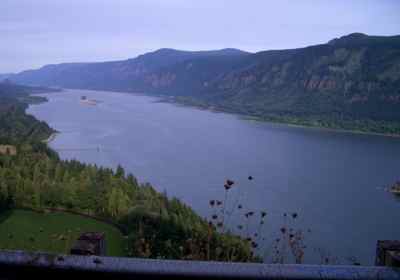 Big fish live here. In the couple of hundred miles between the Bonneville Dam and the Pacific Ocean a million sturgeon reside. Or so the fishery experts say and they should know. The sturgeon migrate up the river as far as the dam and, unable to proceed further, here they spawn. Unlike the salmon, most do not use the fish ladders so there is a concentration of sturgeon in the pool below the dam. The fish is well known to migrate from the Fraser river to the Columbia and vice versa but there are also many resident fish in both rivers who never feel the itch to travel. Just as well. This west coast is the last place on the planet where these fish can thrive, and even here Russian poacher gangs have started to threaten the stocks.
Big fish live here. In the couple of hundred miles between the Bonneville Dam and the Pacific Ocean a million sturgeon reside. Or so the fishery experts say and they should know. The sturgeon migrate up the river as far as the dam and, unable to proceed further, here they spawn. Unlike the salmon, most do not use the fish ladders so there is a concentration of sturgeon in the pool below the dam. The fish is well known to migrate from the Fraser river to the Columbia and vice versa but there are also many resident fish in both rivers who never feel the itch to travel. Just as well. This west coast is the last place on the planet where these fish can thrive, and even here Russian poacher gangs have started to threaten the stocks.
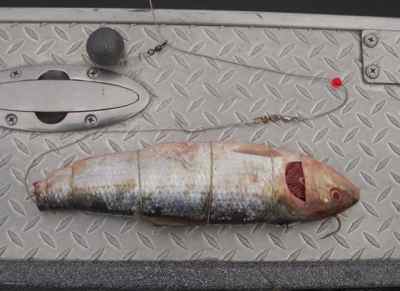 As we have all seen to our dismay in recent years, when the Americans do things badly they really do make a mess. When they get things right however, they are unsurpassable. Their freshwater fishery policies are a superb example of this and we in Europe could learn much from them. One of the excellent rules here is the ‘slot-fish’ policy where a fish can only be taken for the table if (among other constraints) it is above a minimum size and below a maximum size. The smaller size limit ensures the fish has been able to spawn and the larger limit ensures the survival of the gene pool of the larger specimens. Between these length limits are ‘slot-fish’ or ‘keepers’. Columbia river fishery rules allow for ‘keeper sturgeon’ to be taken during the months of May to July – though the fishery is so prolific the quota is often exceeded by the end of June. Sport fishers travel from all over the world to catch these fish all year round; pacific white sturgeon are the ultimate quarry for the freshwater angler. They grow to insane proportions; fish of 1000lb are not uncommon and fish of 10 and 12 foot not considered particularly noteworthy. You do need to be fit if you plan on catching them however.
As we have all seen to our dismay in recent years, when the Americans do things badly they really do make a mess. When they get things right however, they are unsurpassable. Their freshwater fishery policies are a superb example of this and we in Europe could learn much from them. One of the excellent rules here is the ‘slot-fish’ policy where a fish can only be taken for the table if (among other constraints) it is above a minimum size and below a maximum size. The smaller size limit ensures the fish has been able to spawn and the larger limit ensures the survival of the gene pool of the larger specimens. Between these length limits are ‘slot-fish’ or ‘keepers’. Columbia river fishery rules allow for ‘keeper sturgeon’ to be taken during the months of May to July – though the fishery is so prolific the quota is often exceeded by the end of June. Sport fishers travel from all over the world to catch these fish all year round; pacific white sturgeon are the ultimate quarry for the freshwater angler. They grow to insane proportions; fish of 1000lb are not uncommon and fish of 10 and 12 foot not considered particularly noteworthy. You do need to be fit if you plan on catching them however.
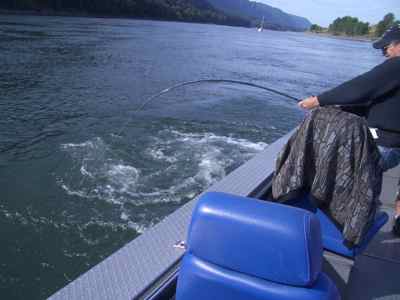 So how big do they grow? It’s hard to say but amongst the reports Wikipedia records:
So how big do they grow? It’s hard to say but amongst the reports Wikipedia records:
“In the 1893 Chicago World’s Fair was exhibited a white sturgeon caught at Astoria on the the Columbia river that was purported to weigh 2,000 pounds, though in Russia, there have been beluga sturgeon caught much larger, with the greatest weighing in at 4,568 pds having been taken from the Caspian Sea. …. The largest recorded sturgeon in the world was caught there at the mouth of the Volga River in 1736. It measured 28 feet long and weighed 4,570 pounds.
Hmm. From the information I’ve been fed in recent years, the Russian sturgeon is no longer a viable quarry for anglers. Over-fishing and crime have taken their toll in the region. Which leaves the west coast of North America. And, to be perfectly honest, I see no point in travelling to a mafia-run river on the Caspian with a few endangered fish when there is a perfectly run prolific fishery in North America with all the attendant luxuries that come with it. The people here are the salt of the earth, the weather is acceptable and the apres-angle is second to none. I love America! Perhaps you’ve noticed. It’s just those nasty clots they tend to vote into power who bugger up the world that I take issue with. The people in the street here are friendly, generous and passionate about their beautiful country. As Winston Churchill once said, you can always trust the American people to elect the right man, even if it is after exhausting all the other possibilities. Very true. Lovely people – and most of them speak a language resembling English. Come here and fish!
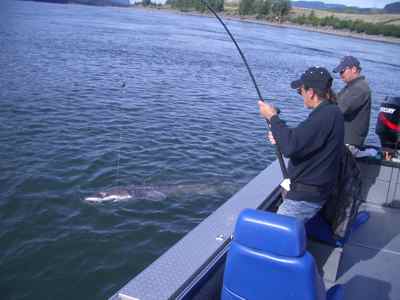 Many anglers I know have a species ‘bucket list’, a list of fish we want to catch before we kick the bucket, and I’ve spent years whittling down my list. This year I ticked a few more off my list with a bonefish on the flyrod in the Spring and a monster of a catfish from the Ebro in the Summer. This trip to the northwest USA I wanted to catch an autumn chinook salmon. The chinook was really just an excuse because in the same waters swim those monster sturgeon which made such an impression on me the last couple of times I fished for them. Those times I was up north in Canada on the Fraser and Harrison rivers and those fish really knocked my socks off. For sheer guts and muscle, sturgeon are without doubt the most powerful fish that swims in a river. Nothing else can compare.
Many anglers I know have a species ‘bucket list’, a list of fish we want to catch before we kick the bucket, and I’ve spent years whittling down my list. This year I ticked a few more off my list with a bonefish on the flyrod in the Spring and a monster of a catfish from the Ebro in the Summer. This trip to the northwest USA I wanted to catch an autumn chinook salmon. The chinook was really just an excuse because in the same waters swim those monster sturgeon which made such an impression on me the last couple of times I fished for them. Those times I was up north in Canada on the Fraser and Harrison rivers and those fish really knocked my socks off. For sheer guts and muscle, sturgeon are without doubt the most powerful fish that swims in a river. Nothing else can compare.
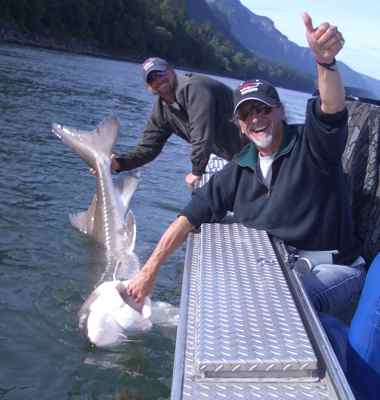 This trip I was the guest of one of the most impressive minds I have met in America, Fred Baker. Fred is now retired after spending 30 odd years as a police detective in Washington State. His stories are fascinating and entertaining but they contain a warning to any inexperienced boaters.
This trip I was the guest of one of the most impressive minds I have met in America, Fred Baker. Fred is now retired after spending 30 odd years as a police detective in Washington State. His stories are fascinating and entertaining but they contain a warning to any inexperienced boaters.
“We used to pull bobbers out the river regularly”.
Sometimes the victims were suicides but often just fishermen who made a mistake – particularly with the anchoring of their boat. Do it right and it’s as safe as houses, but one mistake could be your last. Hence you need a highly experienced boatman, one used to the dangerous moods of this incredible river.
Anchor floats are needed here. These are large buoys with a clever one-way self-locking pulley suspended beneath them. Drop the anchor and let out a lot – a serious length – of rope. The rope passes through the pulley on the float and is securely attached to a cleat on the prow. When it’s time to lift the anchor, start the motor and drive the boat back and above the anchor’s position – whilst avoiding driving over the slack rope of course. Due to the slack rope and the way the pulley works, the float will have slid down the rope and now be directly over the anchor. Drive the boat upstream and tension is re-applied; the power of the motor will lift the anchor vertically until it hits the float where the the pulley mechanism locks it in place. Retrieve the slack rope. No muscles were needed nor animals harmed during the retrieval of this anchor! If you are a regular boating enthusiast you probably know all about this method. If like me you just dabble with boats, it’s a trick worth learning if you have a weak back or heavy anchor and need to anchor up in fast, deep waters.
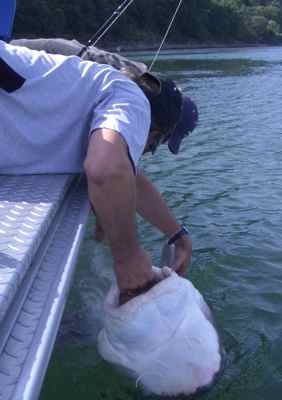 Fred had booked us in for a couple of days with his son’s friend Steve, who runs a guiding service in the area. Steve has an impressive operation. Everything he does he does right. His boat handling skills are second to none and you cannot put your life in a safer pair of hands. Steve is also an extremely experienced fishing guide, he’s been doing it all his life so he ought to be!
Fred had booked us in for a couple of days with his son’s friend Steve, who runs a guiding service in the area. Steve has an impressive operation. Everything he does he does right. His boat handling skills are second to none and you cannot put your life in a safer pair of hands. Steve is also an extremely experienced fishing guide, he’s been doing it all his life so he ought to be!
Our first day out with him was just upstream of the Lewis Clarke Bridge. You may remember seeing the famous piece of film of the American suspension bridge that was taken out in a severe storm, first wobbling dangerously then rippling, twisting and finally collapsing as the cables snapped. Remember it? Well, this is the replacement for that bridge. And Lewis Clark? Famous American exploration team funded by Thos Jefferson to open up America. Worth googling if you like history.
Fred and I pulled up at the dock after a two hour drive. We were late for our chinook session but it didn’t matter, nobody had started catching yet. I was amazed at the huge number of boats out on the river, all tied up in neat lines. There must have been a hundred boats each with four to six anglers on average.
“We call that a Hog-line” explained Fred.
Out in Steve’s boat, watching the sonar cleared up a lot. The depth went from sixty foot to fifty foot in a thirty foot drift and it was to this feature the hog-line was fishing. The technique involved using a 12 ounce lead to take a paternostered 5 inch fluttering spoon down to work the water two foot off the bottom, just at the top of the hump below us.
Despite most boats finding it slow going, we had a few fish that day. I remember a smaller ‘jack’ and a couple of chinook, the best going 25lb to Fred and an 18lber to me. Great fish and a good day but next time I want to catch one on a fly!
We left Steve with the boat and drove inland for an hour and a half. After a mexican meal in a tiny back country town we overnighted in a log-walled motel, sandwiched between the river and the railroad tracks. Every time a train came through it had to blast on it’s steam whistle, so any sleep was an interrupted affair. Not that I cared. I was on vacation in a stunningly beautiful part of the world with great company and good fishing all around me. I lay dozing all night, dreaming of starting an accompanied angling adventure business… Any prospective clients out there?
Next morning we met up with Steve at the boat ramp below the dam. By the time we had the boat in the water and anchored up it was 8am. We fished with legered deadbaits on the hooks in fifty foot of water and I didn’t have to wait long before the first bait was taken. The powerful one piece rod hooped over, the 65lb braid started to click from the Okuma multiplier and the fight was on. Steve unclipped from the mooring and we drifted back down the current whist fighting the fish. The power of these fish is incredible, it just towed us downstream like it never knew we were there. Twenty-five minutes later I finally got the fish alongside the boat. I was breathing hard and my arms were aching. The sight of one of these monsters coming up under the boat is truly (and I know the word is overused) awesome! Without attempting to lift the fish from the water, we measured it against the side of the boat, unhooked it and after ensuring it was fit to go, we released it. It was eight foot long! Eight feet! A new personal best; my previous biggest sturgeon was 6ft 6inches and around 140 – 150lb, from the Fraser 8 years ago.
We hooked up to the anchor float again and dropped fresh baits down.
Fred was insisting that today all the fish would be mine. He didn’t want to fight ‘some damn log’ in the powerful current and was happy to just photograph me working for them. And work I did. Within minutes I was once again playing with a dinosaur – or perhaps it would be more accurate to say it was playing with me. Again I was punched into a pulp before the fish came to the surface. This one was an incredible 9ft 6ins!
I was shattered. My arms felt as if they had been pulled from their sockets and it was as if I had just spent a couple of rounds with Mike Tyson. When the tip of the left hand rod twitched over again it was only adrenaline that made me reach for the rod. But the fish dropped the bait. And 5 mins later it picked it up then dropped it again. And then did it again. And again.
This fish was cagey. Crafty.
A Melville moment came upon me. Feeling some of the madness of Ahab I told Steve that I really wanted this particular fish, so to that end we set a plan in action. We tied a line marker onto the mainline at the spool, then I reeled in. As expected, the bait was mangled and the hook turned. We put on a fresh bait. To a second rod we attached a large float and clipped the deadbeat rig beneath it. With Steve letting out the line on the float rod and me simultaneously feeding the baited hook line back, we finally got down to the line marker. By striking the baited rig loose from the float we were able to present the bait almost exactly to the position the cagey bites had originated. It was a good plan. Within minutes the rod tip twitched – but this time I was holding the rod ready to hit it. Bang, fish on!
Ah. This one felt a lot smaller at first, probably because Steve had unhooked the boat and we were drifting back to the fish’s position. Steve and Fred were both laughing at me because I was obviously unaware of what was in store. I soon found out. After 15 mins my forearms were throbbing. After 30 mins my back was giving out. At the 45 mins mark I wanted to cry – but I couldn’t give up. Inch by inch I finally gained line on the fish and I cannot tell you the relief I felt when, almost an hour later, I eventually saw that fish surface. This one went 9 foot long.
I was punch drunk. I was unable to continue fishing as my arms were ruined. In fact they were still hurting several days later. And no wonder; when I consulted the online weight for length charts, it transpired that in a three hour session I had caught over 1000lb of fish! The smallest going 275lb the middle one at 400lb and the largest at 465lb.
And that’s why I woke up with cramps.
Geoff Maynard : Sept 2009












